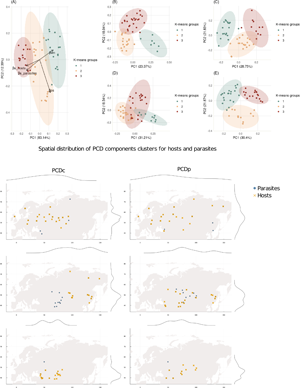Article contents
Beta and phylogenetic diversities tell complementary stories about ecological networks biogeography
Published online by Cambridge University Press: 08 March 2021
Abstract

The beta-diversity of interactions between communities does not necessarily correspond to the differences related to their species composition because interactions show greater variability than species co-occurrence. Additionally, the structure of species interaction networks can itself vary over spatial gradients, thereby adding constraints on the dissimilarity of communities in space. We used published data on the parasitism interaction between fleas and small mammals in 51 regions of the Palearctic to investigate how beta-diversity of networks and phylogenetic diversity are related. The networks could be separated in groups based on the metrics that best described the differences between them, and these groups were also geographically structured. We also found that each network beta-diversity index relates in a particular way with phylogenetically community dissimilarity, reinforcing that some of these indexes have a strong phylogenetic component. Our results clarify important aspects of the biogeography of hosts and parasites communities in Eurasia, while suggesting that networks beta-diversity and phylogenetic dissimilarity interact with the environment in different ways.
- Type
- Research Article
- Information
- Copyright
- Copyright © The Author(s), 2021. Published by Cambridge University Press
References
- 1
- Cited by



